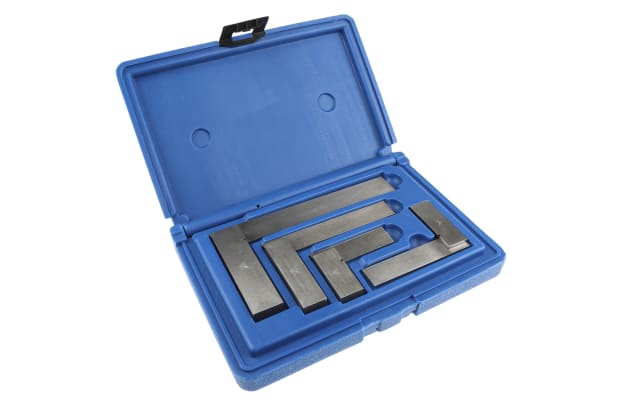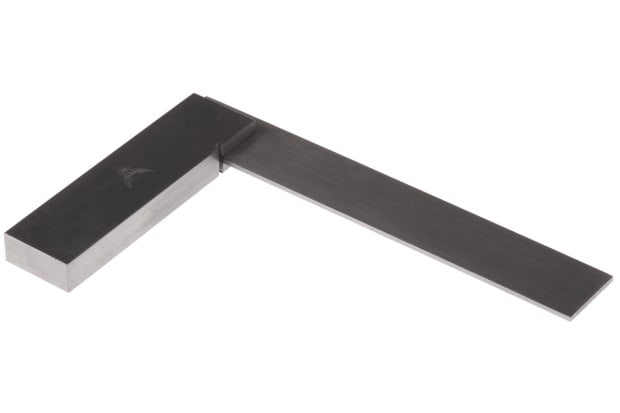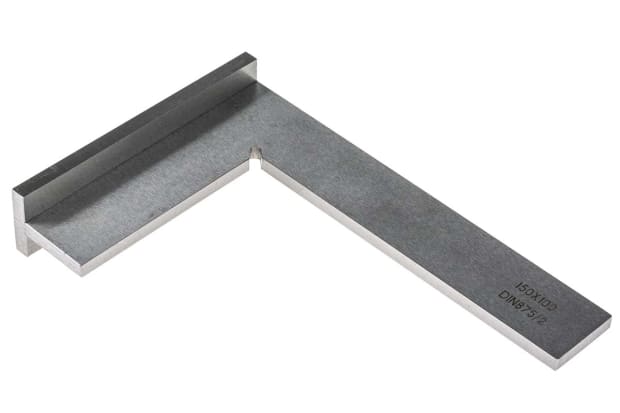- Published 17 Jan 2023
- Last Modified 29 Aug 2023
- 9 min
A Complete Guide to Engineers Squares
Our comprehensive engineer's squares guide explains what they are, their uses, accuracy, types, sizing, and more.

This guide is designed to inform you about the most important aspects of engineer try squares, including exactly what an engineer square is, in what ways it differs from other types of try square, and what engineer square sets are.
By the end of the guide, you will also understand where and why a machinist square is used, what types are available to buy online in the UK, which brands are available, and how to choose the best tool for your needs based on accuracy, materials, and sizing.
What is an Engineers Square?
An engineer’s square is a simple yet versatile hand tool, widely used across many industries, disciplines and projects. Also called machinist squares, they are normally L-shaped metal tools sold in various sizes. Engineers squares are used to accurately check and mark angles, or to verify the squareness of straight edges and lines.
High-quality squares are precision made to form a perfect 90-degree right angle, against which you can test all manner of edges, planes and corners on a workpiece. Since true squareness is essential for almost every kind of carpentry, metalworking, and engineering task, a well-made square is a vital part of many professional tool kits.
When buyers ask, ‘what is an engineer’s square?’, they often want to know the precise difference between these tools and other similar products. They may already be familiar with related items, including combination squares, speed squares, and machinist squares.
While a few of these terms are used interchangeably, there are several important differences. The proper definition of engineers or machinists squares usually includes being made entirely from high-grade metal, typically hardened tool steel.
Engineers Square vs Try Square
Many people will be familiar with the traditional try square for angle measurement and marking. Engineers squares and try squares are very closely related and are used for much the same purpose.
They are similar enough that you may see either name used to refer to the same tool. However, when shopping for engineer squares vs try squares, it is important to be aware of the technical distinctions between them.
Machinists squares are typically made entirely from hardened tool steel. On the other hand, try squares are often made using a wooden handle (the stock), with a metal blade pinned or riveted to it at precisely 90°. Engineers models also tend to have a groove cut at the inside corner of the L. This is for collecting debris or swarf that might otherwise end up trapped beneath the blade, potentially throwing off the measurement.
These key differences in material construction mean that a true machinist square will usually offer greater accuracy. Engineer squares must conform to strict accuracy standards in the UK, and this must be consistent across both the inner and outer blade edges.
Machinist squares were once largely reserved for metalworking tasks, while try squares were usually associated with woodwork. However, engineer squares are now widely preferred for all types of precision angle measurement and workshop jobs.
Engineer Square Uses

Checking for true (i.e. straight and accurate) alignment of edges, planes and angles is by far the most common engineer square use. However, despite being a relatively simple tool, squares are quite versatile in their full range of capabilities.
This is partly why a precision machinist or woodworking square is a hugely important tool in all types of angle measurement and construction tasks. Various types are used daily all over the world, playing key roles in projects ranging from simple fixes to complex, accuracy-critical engineering work. They are commonly associated with jobs such as woodworking, sheet metal fabrication, blacksmithing, roofing, and general building and crafting.
The best woodworking squares can be used for a wide variety of tasks in construction and measuring, including accuracy checking, marking lengths, sawing and cutting square edges, bisecting angles, and finding the dead centre of a circle.
Engineers Square Accuracy
When it comes to choosing and buying an engineer’s square, accuracy is the key defining characteristic of a high-quality product.
These tools are precision manufactured to provide a reliable straight edge and true angle measurement when used properly. Cheap try squares will often be assembled with lesser quality construction methods, which has the potential to greatly reduce the accuracy of measurements.
Traditional wooden-handled try squares are generally held to lower standards of precision than genuine machinist squares, which must meet various accuracy standards to qualify. The most important of these standards are BS 939 for the UK and DIN 875 for Europe. Tools bearing these marks have passed the necessary accuracy gradings for sale as true engineer’s squares.
Accuracy Grades
For machinist squares sold in the UK, BS 939 defines three levels of accuracy - Grade AA, Grade A, and Grade B. Most workshop tools are expected to conform to Grade B, which is precise enough for most professional construction jobs. Grade A engineers squares and above are normally only demanded for laboratory or tool calibration work.
You should also note that BSI Kitemark standards for try squares tend to reflect more than just the accuracy of measurement. They also cover various important metrics like material quality, assembly, rigidity and environmental resilience, signifying a long-lasting and reliable tool.
Engineers Square Types
There are many different sorts of square for sale today. Popular models range from the most basic and traditional try squares to far more robust designs, such as the all-metal engineer's squares used in both carpentry and metalwork.
Larger versions might be labelled as framing squares or drywall squares, performing the same job at increased scale. You can also buy more complex and delicate multi-part tools for use in more detailed tasks. Examples include combination squares and T-bevels (adjustable engineers squares), with slide mechanisms for greater versatility of angle measurement.
Diagonal speed squares are another popular solution for easy line marking and angle checking, although these tend to be significantly smaller. Along with magnetic micro squares, they are more often used for scribing out accurate cut lines on individual timbers or sheet metals than for checking straight edges on big workpieces.
What are Engineers Squares Made of?
True engineer’s squares are almost always constructed entirely from metal. This sets them apart from the traditional carpentry try square, which usually combines a wooden stock with a metal blade. However, it is now common to see all-metal try squares being used for woodworking, too.
Hardened tool steel is often used for high-end squares, with spring steel and stainless steel versions also common. Hardened steel machinist squares tend to offer both greater longevity and more accuracy than wooden-handled versions. There is less scope for play developing between the stock and the blade on an all-metal square, especially if the tool is machined from a single piece of steel.
Depending on the quality and price of the tool, there will often be a range of advanced manufacturing techniques involved in crafting a high-grade engineer square. This could include precision grinding, tempering and lapping of the blade section, and either welding, pinning or riveting the blade to the stock in a two-piece model.
Here at RS, we work with a variety of leading suppliers and brands to supply our full range of durable, accurate engineer squares. Our suppliers include Kleffmann & Weese, Stanley, Starrett, and Facom. We also have our in-house line of RS PRO precision tools, offering the same exacting durability and accuracy standards.
Sizing
Sizing is an important factor to consider when choosing the best engineers square for a particular job. Engineer try square sizes generally refer to the length of the blade section along its innermost edge. Handles or stocks can come in varying lengths relative to the blade, depending on the type of square you are using.
Both small and large engineer’s squares are readily available. As with all hand tools, you will have a much easier time completing projects to a high standard when using an appropriately sized tool for the workpiece. For optimal accuracy, you ideally want a blade to cover the full length of whatever you are measuring or marking. Try to avoid too much excess length, which can make it awkward and unwieldy to move around.
Sizes may be stated in metric or imperial units (mm or inches) depending on the tool brand and will often be given in both. Popular lengths for small engineer’s squares tend to start from around 3”/75mm, which is a handy size for working with very compact joints. Common sizes feature 6”-12” (150mm-300mm) blades, suited to a wide range of projects like cabinetmaking and crosscut measurement.
Larger tools often feature blades of 24” (600mm) upwards, and it is not uncommon for some professionals to use engineer squares of 1000mm or more. Very large versions are more likely to be found in heavy-duty industrial settings than woodworking tool bags, but they are beneficial for specialist applications.

What is an Engineers Square Set?
A precision engineering square set includes multiple sizes of try square or straightedge. They are often sold in matching sets of four, along with some form of handy carrying case for easier tool storage between jobs. These sets cover a range of common sizes and are highly useful for dozens of everyday workshop and inspection tasks.
If you want to be able to tackle a greater variety of jobs and workpiece sizes more easily, it makes sense to buy an engineer’s square set when starting out. Both small and large square sets will normally be sold at a net discount when purchasing multiple tools in a single package. This will often prove considerably cheaper than picking up individual tools as and when you find you need them.




